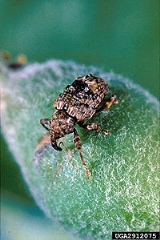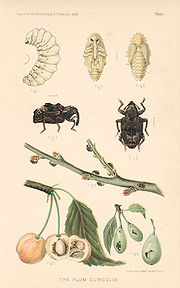
Plum curculio
Encyclopedia
The plum curculio is a true weevil native to the regions east of the Rocky Mountains
in the United States
and Canada
. It is notorious for destroying fruits if left uncontrolled.

, including plum
s, peach
es, apple
s, pear
s, and other stone fruits. After the female has chosen a suitable host, she will build an egg chamber under the fruit skin to receive the egg. She then turns around and places the egg in the cavity. Next, she slices a curved slit underneath the egg cavity to leave the egg in a flap of flesh. Eggs that do not hatch are killed from the pressure presented by the growth of the host fruit, resulting in crescent-shaped scars visible on the outside of the fruit.
long when fully grown. After such, the beetle reaches the pupa
l stage measuring about 5 to 7 mm, all adult characteristics are visible in this stage prior to transformation. Adult plum curculio are about 4 to 6 mm and have a small, rough, snout colored with black, gray, and brown specks. Four pairs of ridges cover the wings
; however, because of the middle humps it only appears to have two ridges.
, peach, apricot
, pear and quince
. It may also survive on wild plum, hawthorn
, and crabapple
. It is found most commonly in areas east of the Rocky Mountains and in eastern Canada
. The beetles are most active during the spring time when the weather is warm, damp, and cloudy. They are often seen in heavy leafed trees.
Rocky Mountains
The Rocky Mountains are a major mountain range in western North America. The Rocky Mountains stretch more than from the northernmost part of British Columbia, in western Canada, to New Mexico, in the southwestern United States...
in the United States
United States
The United States of America is a federal constitutional republic comprising fifty states and a federal district...
and Canada
Canada
Canada is a North American country consisting of ten provinces and three territories. Located in the northern part of the continent, it extends from the Atlantic Ocean in the east to the Pacific Ocean in the west, and northward into the Arctic Ocean...
. It is notorious for destroying fruits if left uncontrolled.

Life stages
A female curculio uses a number of hosts to lay her eggsEgg (biology)
An egg is an organic vessel in which an embryo first begins to develop. In most birds, reptiles, insects, molluscs, fish, and monotremes, an egg is the zygote, resulting from fertilization of the ovum, which is expelled from the body and permitted to develop outside the body until the developing...
, including plum
Plum
A plum or gage is a stone fruit tree in the genus Prunus, subgenus Prunus. The subgenus is distinguished from other subgenera in the shoots having a terminal bud and solitary side buds , the flowers in groups of one to five together on short stems, and the fruit having a groove running down one...
s, peach
Peach
The peach tree is a deciduous tree growing to tall and 6 in. in diameter, belonging to the subfamily Prunoideae of the family Rosaceae. It bears an edible juicy fruit called a peach...
es, apple
Apple
The apple is the pomaceous fruit of the apple tree, species Malus domestica in the rose family . It is one of the most widely cultivated tree fruits, and the most widely known of the many members of genus Malus that are used by humans. Apple grow on small, deciduous trees that blossom in the spring...
s, pear
Pear
The pear is any of several tree species of genus Pyrus and also the name of the pomaceous fruit of these trees. Several species of pear are valued by humans for their edible fruit, but the fruit of other species is small, hard, and astringent....
s, and other stone fruits. After the female has chosen a suitable host, she will build an egg chamber under the fruit skin to receive the egg. She then turns around and places the egg in the cavity. Next, she slices a curved slit underneath the egg cavity to leave the egg in a flap of flesh. Eggs that do not hatch are killed from the pressure presented by the growth of the host fruit, resulting in crescent-shaped scars visible on the outside of the fruit.
Appearance
Plum curculio larva are typically 6 to 9 mmMillimetre
The millimetre is a unit of length in the metric system, equal to one thousandth of a metre, which is the SI base unit of length....
long when fully grown. After such, the beetle reaches the pupa
Pupa
A pupa is the life stage of some insects undergoing transformation. The pupal stage is found only in holometabolous insects, those that undergo a complete metamorphosis, going through four life stages; embryo, larva, pupa and imago...
l stage measuring about 5 to 7 mm, all adult characteristics are visible in this stage prior to transformation. Adult plum curculio are about 4 to 6 mm and have a small, rough, snout colored with black, gray, and brown specks. Four pairs of ridges cover the wings
Insect wing
Insects are the only group of invertebrates known to have evolved flight. Insects possess some remarkable flight characteristics and abilities, still far superior to attempts by humans to replicate their capabilities. Even our understanding of the aerodynamics of flexible, flapping wings and how...
; however, because of the middle humps it only appears to have two ridges.
Hosts
The plum curculio can be found in apple, nectarine, plum, cherryCherry
The cherry is the fruit of many plants of the genus Prunus, and is a fleshy stone fruit. The cherry fruits of commerce are usually obtained from a limited number of species, including especially cultivars of the wild cherry, Prunus avium....
, peach, apricot
Apricot
The apricot, Prunus armeniaca, is a species of Prunus, classified with the plum in the subgenus Prunus. The native range is somewhat uncertain due to its extensive prehistoric cultivation.- Description :...
, pear and quince
Quince
The quince , or Cydonia oblonga, is the sole member of the genus Cydonia and native to warm-temperate southwest Asia in the Caucasus region...
. It may also survive on wild plum, hawthorn
Crataegus
Crataegus , commonly called hawthorn or thornapple, is a large genus of shrubs and trees in the rose family, Rosaceae, native to temperate regions of the Northern Hemisphere in Europe, Asia and North America. The name hawthorn was originally applied to the species native to northern Europe,...
, and crabapple
Crabapple
Crabapple is a term used for several species of Malus in the family Rosaceae, which are characterized by small sour fruit resembling familiar table apples . They are usually small trees or shrubs....
. It is found most commonly in areas east of the Rocky Mountains and in eastern Canada
Canada
Canada is a North American country consisting of ten provinces and three territories. Located in the northern part of the continent, it extends from the Atlantic Ocean in the east to the Pacific Ocean in the west, and northward into the Arctic Ocean...
. The beetles are most active during the spring time when the weather is warm, damp, and cloudy. They are often seen in heavy leafed trees.

